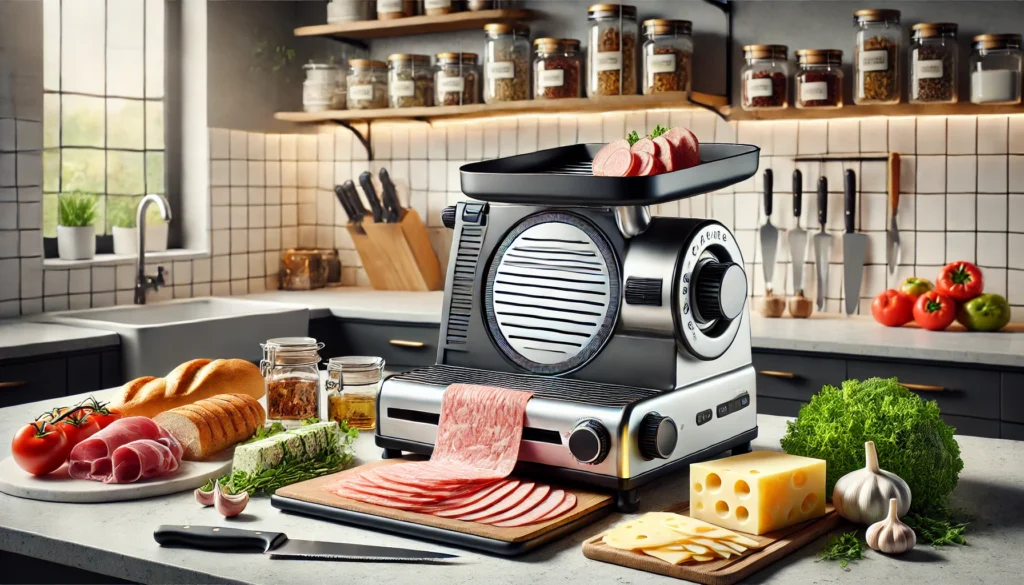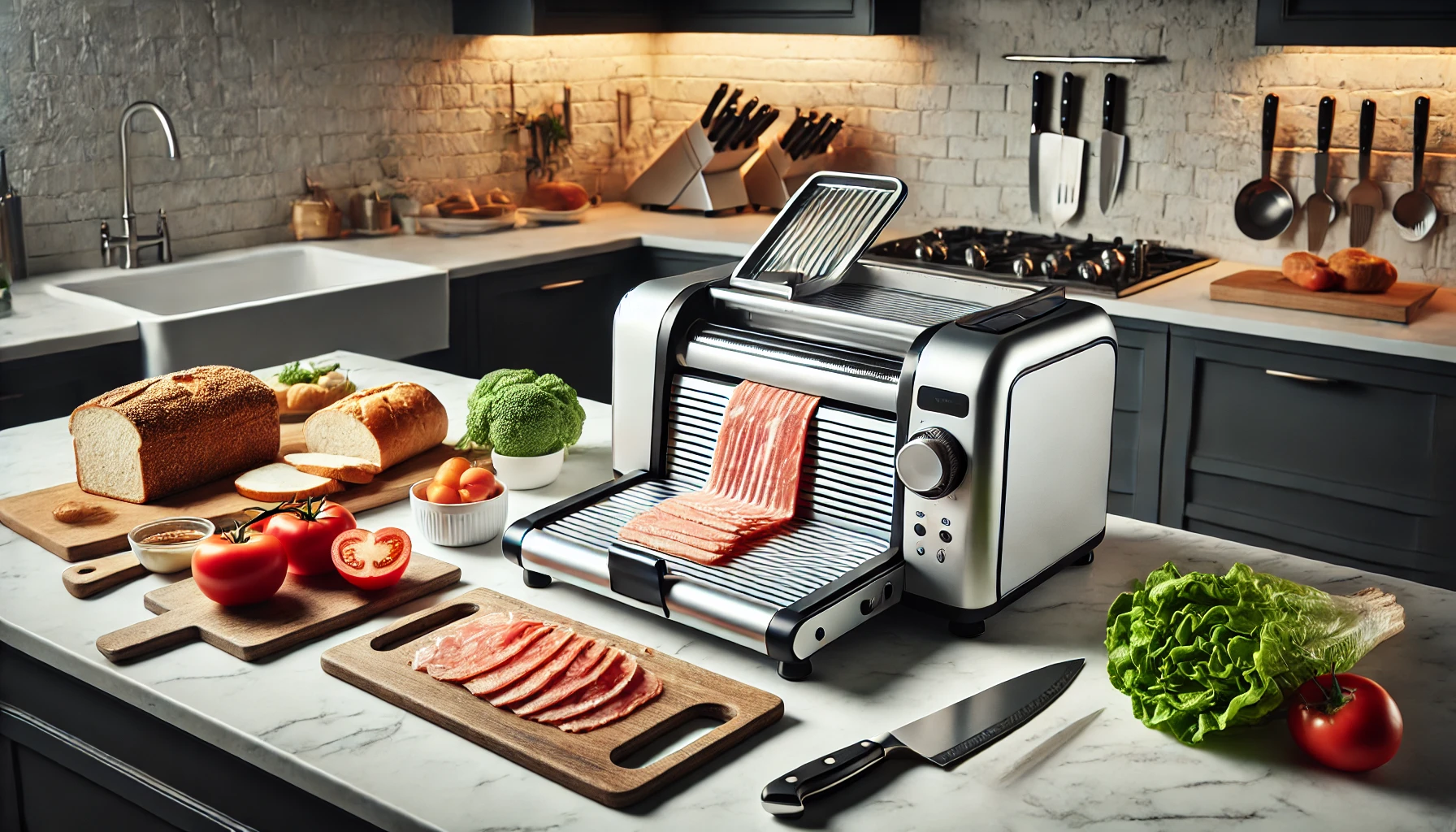If you’re passionate about cooking or enjoy preparing meals at home, you know how important it is to have the right tools in your kitchen. One of those tools that can elevate your culinary experience is a meat and food slicer. Whether you’re slicing meats, cheeses, vegetables, or bread, this handy appliance can save you time and effort while providing precision slices every time. In this article, we’ll dive into why a meat and food slicer is a must-have and how it can make your meal prep faster, easier, and more enjoyable.
What is a Meat and Food Slicer?
A meat and food slicer is a kitchen appliance designed to slice through various types of food, particularly meats, with ease. It typically features a sharp, rotating blade and an adjustable thickness setting, allowing you to slice foods to your preferred thickness. Whether you’re slicing delicate prosciutto or thick cuts of roast beef, a meat slicer can do it all with precision and consistency.
In addition to meats, many food slicers can handle cheeses, fruits, vegetables, and even bread. This versatility makes them a valuable tool in both professional kitchens and home kitchens alike.
Why You Need a Meat and Food Slicer
1. Perfectly Even Slices Every Time
One of the biggest advantages of using a meat and food slicer is the consistency it offers. When slicing by hand, it’s easy to end up with uneven slices, especially when you’re working with something like meat, which can be tricky to cut thinly. A food slicer, however, ensures that each slice is of the same thickness, giving your meals a professional touch. Whether you’re preparing sandwiches, deli platters, or charcuterie boards, your slices will be uniform and precise.
2. Save Time on Meal Prep
Using a meat and food slicer can significantly speed up your meal prep. Cutting large amounts of meat or vegetables by hand can be time-consuming and labor-intensive. With a slicer, you can cut through large quantities of food in a fraction of the time it would take to do it manually. This is particularly helpful for busy families or individuals who want to get dinner on the table faster.
3. More Control Over Thickness
A meat and food slicer allows you to customize the thickness of your slices to suit your recipe or personal preference. From paper-thin slices of prosciutto to thick-cut roast beef, the slicer’s adjustable settings give you full control over the thickness of your cuts. This flexibility is ideal for a variety of dishes, including sandwiches, salads, or even meat and cheese platters.
4. Better Value for Money
Buying pre-sliced deli meats or cheeses from the store can be more expensive than purchasing the whole product. With a meat slicer, you can buy meats, cheeses, and even bread in bulk and slice them yourself. Not only does this save you money, but it also reduces the amount of packaging waste you generate, making it an eco-friendly choice.
5. Great for Special Occasions
Planning a party or hosting a special dinner? A meat and food slicer can help you prepare impressive platters of sliced meats, cheeses, and other foods that will wow your guests. Whether you’re preparing a charcuterie board, a deli platter, or even homemade sandwiches, a slicer allows you to serve food that looks just as good as it tastes.
Types of Meat and Food Slicers
There are several different types of meat and food slicers to choose from, depending on your needs and kitchen space. Let’s explore the most common options:
1. Manual Meat Slicers
Manual meat slicers are operated by turning a hand-crank to move the food towards the blade. These are often more affordable and compact, making them a good option for people with limited kitchen space. However, they require more effort to operate and may not be as efficient for large quantities of food.
2. Electric Meat Slicers
Electric meat slicers are more powerful and easier to use than manual models. They feature a motor that drives the blade, making them ideal for slicing large quantities of food quickly and effortlessly. These slicers are also more precise, with adjustable settings for slice thickness. While they are more expensive, they offer convenience and efficiency, especially for those who slice food frequently.
3. Commercial-Grade Meat Slicers
For those who want the best of the best, commercial-grade meat slicers offer professional-level performance. These slicers are often used in restaurants and butcher shops and are built for heavy-duty use. They are larger, more powerful, and capable of handling very large quantities of food. If you do a lot of meal prep or run a business, a commercial slicer may be the right choice for you.
Features to Look for in a Meat and Food Slicer

When shopping for a meat and food slicer, there are a few key features to consider to ensure you get the best one for your needs:
- Blade Material: Stainless steel blades are the most common and provide long-lasting sharpness and durability. Ensure the blade is sharp and easy to clean.
- Thickness Adjustment: Look for a slicer that allows you to adjust the slice thickness, whether you need paper-thin or thicker slices.
- Safety Features: Safety should always be a top priority. Look for features like safety guards, non-slip feet, and a blade cover to protect your hands and fingers.
- Ease of Cleaning: Make sure the slicer is easy to disassemble and clean, especially if you’re slicing raw meat.
- Motor Power: For electric slicers, consider the motor power to ensure it can handle your slicing needs efficiently.
- Size and Storage: If you have limited counter space, consider a compact model that is easy to store when not in use.
How to Use a Meat and Food Slicer Safely
Using a meat and food slicer is easy, but it’s important to follow some safety guidelines to avoid accidents:
- Always Use the Safety Guard: Most slicers come with a food safety guard that holds the food in place as you slice. Always use it to avoid direct contact with the blade.
- Keep Hands Clear of the Blade: Never place your fingers near the blade while it’s in use. Always use the food pusher or safety guard.
- Slice on a Stable Surface: Ensure your slicer is on a flat, stable surface to prevent it from moving around during use.
- Turn Off When Not in Use: Always turn off and unplug the slicer when you’re finished using it or when you’re making adjustments to the machine.
- Clean After Every Use: Regular cleaning is essential to keep the slicer in top condition. Make sure to clean the blade, carriage, and any removable parts after each use.
Conclusion
A meat and food slicer is an incredibly versatile and time-saving tool for your kitchen. Whether you’re slicing meats, cheeses, vegetables, or bread, this appliance offers precision, consistency, and convenience. With the ability to adjust the thickness, save money on pre-sliced products, and enhance your meal presentation, a meat slicer is a game-changer for home chefs.
By investing in a quality meat and food slicer, you can elevate your cooking game, save time, and prepare delicious meals with ease. Whether you’re a home cook or a professional chef, a slicer is a kitchen tool you won’t want to miss!
FAQs
- Can I slice frozen meat with a meat slicer?
- It’s not recommended to slice frozen meat as it can damage the blade. It’s best to slightly thaw meat before slicing.
- Are meat slicers easy to clean?
- Yes, most meat slicers are designed to be easy to clean. Make sure to follow the manufacturer’s cleaning instructions to avoid damage.
- Do I need an electric meat slicer for home use?
- If you only slice food occasionally, a manual slicer should suffice. However, for frequent use, an electric slicer will save time and effort.
- How long does a meat slicer blade last?
- With proper maintenance, a high-quality slicer blade can last for years. However, regular sharpening or replacement may be necessary depending on usage.

